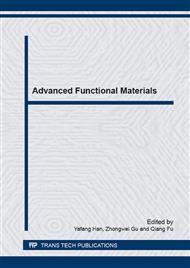[1]
Long M, Rack H, Titanium alloys in total joint replacement-a materials science perspective, Boimaterials. 19 (1998) 1621-39.
DOI: 10.1016/s0142-9612(97)00146-4
Google Scholar
[2]
Nishiguchi S, Nakamura T, Kobayashi M, Kim HM, Miyaji F, Kokubo T, The effect of heat treatment on bone-bonding ability of alkali-treated titanium, Biomaterials. 20 (1999) 491-500.
DOI: 10.1016/s0142-9612(98)90203-4
Google Scholar
[3]
Niinomi M, Mechanical properties of biomedical titanium alloys, Mater Sci Eng A. 243 (1998) 231-6.
Google Scholar
[4]
Dunand DC, Processing of titanium foams, Adv Eng Mater. 6 (2004) 369-76.
Google Scholar
[5]
Guibao Q, Jian X, Jianyang Z, Yilong L, Chenguang B, Jing Z, Processing and mechanical properties of titanium foams enhanced by Er2O3 for biomedical applications, Mater Tech. 29 (2014) 118-23.
DOI: 10.1179/175355513x13714631096860
Google Scholar
[6]
Torres Y, Rodriguez JA, Arias S, Echeverry M, Robledo S, Amigo V, et al., Processing, characterization and biological testing of porous titanium obtained by space-holder technique, J Mter Sci. 47 (2012) 6565-76.
DOI: 10.1007/s10853-012-6586-9
Google Scholar
[7]
Laptev A, Vyal O, Bram M, Buchkremer HP, Stover D, Green strength of powder compacts provided production of highly porous titanium parts, Powder Metall. 48 (2005) 358-64.
DOI: 10.1179/174329005x73838
Google Scholar
[8]
Laptev A, Bram M, Buchkremer H, Stöver D, Study of production route for titanium parts combining very high porosity and complex shape, Powder Metall. 47 (2004) 85-92.
DOI: 10.1179/003258904225015536
Google Scholar
[9]
Wen C, Yamada Y, Shimojima K, Chino Y, Asahina T, Mabuchi M, Processing and mechanical properties of autogenous titanium implant materials, J Mater Sci: Mater Medic. 13 (2002) 397-401.
DOI: 10.1023/a:1014344819558
Google Scholar
[10]
Bansiddhi A, Dunand DC, Shape-memory NiTi foams produced by solid-state replication with NaF, Intermetallics. 15 (2007) 1612-22.
DOI: 10.1016/j.intermet.2007.06.013
Google Scholar
[11]
Hong T, Guo Z, Yang R, Fabrication of porous titanium scaffold materials by a fugitive filler method, J Mater Sci: Mater Medic. 19 (2008) 3489-95.
DOI: 10.1007/s10856-008-3527-x
Google Scholar
[12]
Chino Y, Dunand DC, Creating Aligned, Elongated Pores in Titanium Foams by Swaging of Preforms with Ductile Space‐Holder, Adv Eng Mater. 11 (2009) 52-5.
DOI: 10.1002/adem.200800232
Google Scholar
[13]
Torres Y, Pavon JJ, Rodriguez JA, Processing and characterization of porous titanium for implants by using NaCl as space holder, J Mater Pro Tech. 212 (2012) 1061-9.
DOI: 10.1016/j.jmatprotec.2011.12.015
Google Scholar
[14]
Ye B, Dunand DC, Titanium foams produced by solid-state replication of NaCl powders, Mater Sci Eng A. 528 (2010) 691-7.
DOI: 10.1016/j.msea.2010.09.054
Google Scholar
[15]
Bansiddhi A, Dunand D, Shape-memory NiTi foams produced by replication of NaCl space-holders, Acta Biomater. 4 (2008) 1996-(2007).
DOI: 10.1016/j.actbio.2008.06.005
Google Scholar
[16]
Mansourighasri A, Muhamad N, Sulong A, Processing titanium foams using tapioca starch as a space holder, J Mater Pro Tech. 212 (2012) 83-9.
DOI: 10.1016/j.jmatprotec.2011.08.008
Google Scholar
[17]
Esen Z, Bor Ş, Processing of titanium foams using magnesium spacer particles, Scripta Mater. 56 (2007) 341-4.
DOI: 10.1016/j.scriptamat.2006.11.010
Google Scholar
[18]
Kwok PJ, Oppenheimer SM, Dunand DC, Porous Titanium by Electro‐chemical Dissolution of Steel Space‐holders, Adv Eng Mater. 10 (2008) 820-5.
DOI: 10.1002/adem.200800072
Google Scholar
[19]
Bram M, Stiller C, Buchkremer HP, Stöver D, Baur H, High‐Porosity Titanium, Stainless Steel, and Superalloy Parts, Adv Eng Mater. 2 (2000) 196-9.
DOI: 10.1002/(sici)1527-2648(200004)2:4<196::aid-adem196>3.0.co;2-k
Google Scholar
[20]
Niu W, Bai C, Qiu G, Wang Q, Processing and properties of porous titanium using space holder technique, Mater Sci Eng A. 506 (2009) 148-51.
DOI: 10.1016/j.msea.2008.11.022
Google Scholar
[21]
Sharma M, Gupta GK, Modi OP, Prasad BK, Gupta AK, Titanium foam through powder metallurgy route using acicular urea particles as space holder, Mater Lett. 65 (2011) 3199-201.
DOI: 10.1016/j.matlet.2011.07.004
Google Scholar
[22]
Tuncer N, Arslan G, Maire E, Salvo L, Investigation of spacer size effect on architecture and mechanical properties of porous titanium, Mater Sci Eng A. 530 (2011) 633-42.
DOI: 10.1016/j.msea.2011.10.036
Google Scholar
[23]
Dezfuli SN, Sadrnezhaad S, Shokrgozar M, Bonakdar S, Fabrication of biocompatible titanium scaffolds using space holder technique, J Mater Sci: Mater Medic. (2012) 1-6.
DOI: 10.1007/s10856-012-4706-3
Google Scholar
[24]
Sharma M, Gupta G, Modi O, Prasad B, PM processed titanium foam: influence of morphology and content of space holder on microstructure and mechanical properties, Powder Metall. 56 (2012) 55-60.
DOI: 10.1179/1743290112y.0000000036
Google Scholar
[25]
Xiao Jian, Qiu Guibao, Liao Yilong, Bai Chenguang, The microstructure and mechanical properties of titanium foams prepared by using carbamide as spacer particles, Rare Met Mater Eng. In press. (2013).
Google Scholar
[26]
Xiao Jian, Qiu Guibao, Liao Yilong, Bai Chenguang, The Effects of Spacer Size on Pore structure of Titanium Foams, Rare Met Mater Eng. In press. (2014).
Google Scholar
[27]
Ashby MF, Evans AG, Fleck NA, Gibson LJ, Hutchinson JW, Wadley HNG, Metal foams: a design guideAmsterdam, Netherlands, (2000).
DOI: 10.1016/b978-075067219-1/50001-5
Google Scholar
[28]
Gibson LJ, Ashby MF, Cellular solids: structure and propertiesCambridge, UK, (1999).
Google Scholar
[29]
Imwinkelried T, Mechanical properties of open‐pore titanium foam, J Biome Mater Res A. 81 (2007) 964-70.
Google Scholar
[30]
Yang S, Leong KF, Du Z, Chua CK, The design of scaffolds for use in tissue engineering. Part I. Traditional factors, Tissue engineering. 7 (2001) 679-89.
DOI: 10.1089/107632701753337645
Google Scholar
[31]
Müller U, Imwinkelried T, Horst M, Sievers M, Graf-Hausner U, Do human osteoblasts grow into open-porous titanium, Eur Cell Mater. 11 (2006) 8-15.
DOI: 10.22203/ecm.v011a02
Google Scholar


